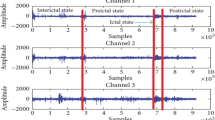Abstract
Epilepsy is a brain disease that affects about 50 million people worldwide. It is characterized by excessive discharges in brain cells, leading the patient to have seizures, loss of consciousness, and alteration of the senses, among others. It is estimated that 5 million cases of this pathology are diagnosed annually. The most commonly used method to diagnose the disease is an electroencephalogram (EEG), which contains information about brain functions and is inexpensive. After the EEG is performed, it is observed by a professional to confirm or rule out the disease; however, this can be a delayed process, thus affecting a possible early treatment of the pathology. Those are why deep learning models have been used to create neural networks that can automatically classify this disease, thus facilitating the work of physicians and reducing time. This paper demonstrated that the deep learning model is more efficient than the machine learning model for pathology classification with an accuracy of 0.9767.
Access this chapter
Tax calculation will be finalised at checkout
Purchases are for personal use only
Similar content being viewed by others
References
Abiodun, O.I., Jantan, A., Omolara, A.E., Dada, K.V., Mohamed, N.A., Arshad, H.: State-of-the-art in artificial neural network applications: a survey. Heliyon 4(11), e00938 (2018)
Andrzejak, R.G., Lehnertz, K., Mormann, F., Rieke, C., David, P., Elger, C.E.: Indications of nonlinear deterministic and finite-dimensional structures in time series of brain electrical activity: dependence on recording region and brain state. Phys. Rev. E 64(6), 061907 (2001)
Arunkumar, N., Ramkumar, K., Venkatraman, V., Abdulhay, E., Fernandes, S.L., Kadry, S., Segal, S.: Classification of focal and non focal EEG using entropies. Pattern Recognit. Lett. 94, 112–117 (2017)
Beghi, E.: The epidemiology of epilepsy. Neuroepidemiology 54(2), 185–191 (2020)
Benbadis, S.R., Beniczky, S., Bertram, E., MacIver, S., Moshé, S.L.: The role of EEG in patients with suspected epilepsy. Epileptic Disord. 22(2), 143–155 (2020)
Breiman, L.: Random forests. Mach. Learn. 45, 5–32 (2001)
Chen, C., Liu, Z., Li, H., Zhou, R., Zhang, Y., Liu, R.: EEG detection based on wavelet transform and SVM method. In: 2016 IEEE International Conference on Smart Cloud (SmartCloud), pp. 241–247. IEEE (2016)
Friedman, J.H.: Stochastic gradient boosting. Comput. Stat. Data Anal. 38(4), 367–378 (2002)
Géron, A.: Hands-on machine learning with Scikit-Learn, Keras, and TensorFlow. O’Reilly Media, Inc. (2022)
Gholami, R., Fakhari, N.: Support vector machine: principles, parameters, and applications. In: Handbook of Neural Computation, pp. 515–535. Elsevier (2017)
Gu, J., Wang, Z., Kuen, J., Ma, L., Shahroudy, A., Shuai, B., Liu, T., Wang, X., Wang, G., Cai, J., et al.: Recent advances in convolutional neural networks. Pattern Recognit. 77, 354–377 (2018)
Lu, E., Pyatka, N., Burant, C.J., Sajatovic, M.: Systematic literature review of psychiatric comorbidities in adults with epilepsy. J. Clin. Neurol. (Seoul, Korea) 17(2), 176 (2021)
Organization, W.H., et al.: Epilepsy: A Public Health Imperative. World Health Organization (2019)
Perera, N.D., Madarasingha, C., De Silva, A.C.: Spatial feature reduction in long-term EEG for patient-specific epileptic seizure event detection. In: Proceedings of the 9th International Conference on Signal Processing Systems, pp. 230–234 (2017)
San-Segundo, R., Gil-Martín, M., D’Haro-Enríquez, L.F., Pardo, J.M.: Classification of epileptic EEG recordings using signal transforms and convolutional neural networks. Comput. Biol. Med. 109, 148–158 (2019)
Saxe, A., Nelli, S., Summerfield, C.: If deep learning is the answer, what is the question? Nat. Rev. Neurosci. 22(1), 55–67 (2021)
Şengür, A., Guo, Y., Akbulut, Y.: Time-frequency texture descriptors of EEG signals for efficient detection of epileptic seizure. Brain Inform. 3, 101–108 (2016)
Tabares-Soto, R., Arteaga-Arteaga, H.B., Mora-Rubio, A., Bravo-Ortíz, M.A., Arias-Garzón, D., Alzate-Grisales, J.A., Orozco-Arias, S., Isaza, G., Ramos-Pollán, R.: Sensitivity of deep learning applied to spatial image steganalysis. PeerJ Comput. Sci. 7, e616 (2021)
Thara, D., PremaSudha, B., Xiong, F.: Auto-detection of epileptic seizure events using deep neural network with different feature scaling techniques. Pattern Recognit. Lett. 128, 544–550 (2019)
Türk, Ö., Özerdem, M.S.: Epilepsy detection by using scalogram based convolutional neural network from EEG signals. Brain Sci. 9(5), 115 (2019)
Xu, G., Ren, T., Chen, Y., Che, W.: A one-dimensional cnn-lstm model for epileptic seizure recognition using EEG signal analysis. Front. Neurosci. 14, 578126 (2020)
Author information
Authors and Affiliations
Corresponding author
Editor information
Editors and Affiliations
Rights and permissions
Copyright information
© 2023 The Author(s), under exclusive license to Springer Nature Switzerland AG
About this paper
Cite this paper
Patiño-Claros, M.A., Holguin-García, S.A., Daza-Chica, A.E., Tabares-Soto, R., Bravo-Ortiz, M.A. (2023). Epileptic Seizure Prediction Methods Using Machine Learning and Deep Learning Models. In: Castillo Ossa, L.F., Isaza, G., Cardona, Ó., Castrillón, O.D., Corchado Rodriguez, J.M., De la Prieta Pintado, F. (eds) Trends in Sustainable Smart Cities and Territories . SSCT 2023. Lecture Notes in Networks and Systems, vol 732. Springer, Cham. https://doi.org/10.1007/978-3-031-36957-5_21
Download citation
DOI: https://doi.org/10.1007/978-3-031-36957-5_21
Published:
Publisher Name: Springer, Cham
Print ISBN: 978-3-031-36956-8
Online ISBN: 978-3-031-36957-5
eBook Packages: Intelligent Technologies and RoboticsIntelligent Technologies and Robotics (R0)




